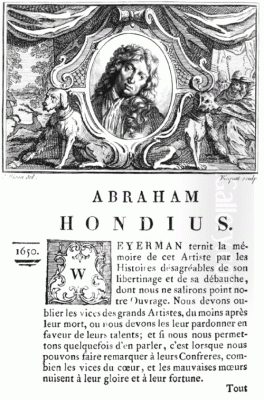
Abraham Danielsz Hondius stands as a significant, albeit sometimes overlooked, figure within the rich tapestry of Dutch Golden Age painting. Active during a period of immense artistic innovation and production, Hondius carved a distinct niche for himself, primarily as a painter of animals, particularly dogs, and dramatic hunting scenes. His career spanned several major European art centers – Rotterdam, Amsterdam, and London – and his work reflects a fascinating blend of Dutch realism and Flemish dynamism, absorbing influences while striving for a unique artistic voice. Though perhaps not as universally renowned as some of his contemporaries, his skill in capturing the energy and anatomy of the animal world, combined with his versatility across various genres, secures his place in art history.
Early Life and Artistic Formation in Rotterdam
Abraham Danielsz Hondius (sometimes recorded as de Hondt) was born in Rotterdam, likely around 1631, although some sources suggest a slightly earlier date like 1625. His father, Daniel Abramsz de Hondt, was a city stonemason, providing a connection to the craft world, though not directly to painting. His mother hailed from Zierikzee in the northern Netherlands. It was in the bustling port city of Rotterdam that the young Hondius received his foundational artistic training.
Evidence points strongly towards him studying under two notable Rotterdam artists: Pieter de Bloot (c. 1601–1658) and Cornelis Saftleven (1607–1681). Both painters likely left their mark on the developing artist. De Bloot was known for his peasant scenes and landscapes, often imbued with a lively, sometimes coarse, realism. Saftleven, perhaps the more significant influence, was highly versatile, painting genre scenes, portraits, landscapes, and notably, animals and mythological scenes, sometimes featuring fantastical elements. Saftleven's detailed observation of animals and his ability to integrate them into various settings would have provided a valuable model for Hondius. The impact of these early teachers can be discerned in Hondius's initial works, which demonstrate a grasp of detailed rendering and composition characteristic of the Rotterdam school.
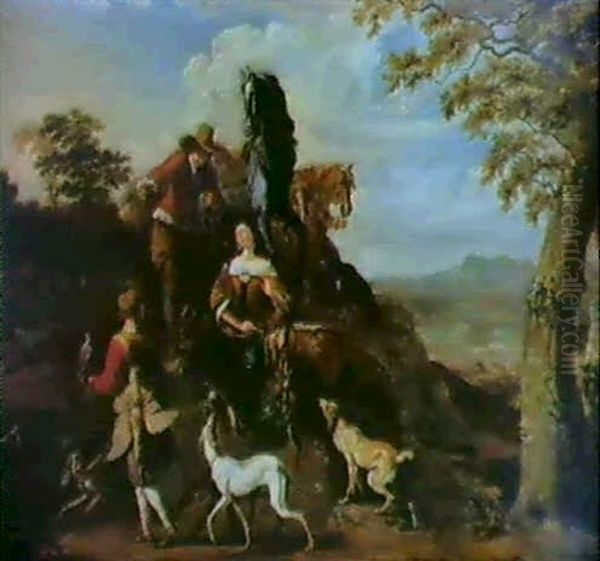
Hondius emerged as a capable artist relatively early. His first known dated works appear around 1651, when he would have been about twenty years old. A piece like Hounds Resting from this year already showcases his burgeoning talent and his early inclination towards animal subjects, particularly the depiction of dogs, which would become a hallmark of his oeuvre. These initial paintings reveal a promising artist absorbing the lessons of his masters while beginning to explore the themes that would dominate his career. He remained active in Rotterdam until approximately 1659, establishing his reputation within the local art scene.
Artistic Influences: Dutch Roots and Flemish Flair
While rooted in the Dutch tradition learned in Rotterdam, Hondius's artistic development was significantly shaped by exposure to Flemish painting, particularly the Antwerp school's masters of animal and hunt scenes. The influence of artists like Frans Snyders (1579–1657) and Jan Fyt (1611–1661) is palpable in many of Hondius's works. Snyders, a pupil of Pieter Brueghel the Younger and Hendrick van Balen, was renowned for his large-scale, energetic depictions of market scenes, still lifes laden with game, and violent animal hunts or fights. His dynamic compositions and vigorous brushwork set a high bar for animal painting.
Jan Fyt, himself a student of Snyders, continued this tradition but often brought a greater elegance and a more refined touch to his depictions of game, hunting trophies, and live animals, frequently set within landscapes. The dramatic intensity and anatomical accuracy found in the works of Snyders and Fyt clearly resonated with Hondius. He likely knew their compositions through direct observation if he travelled, or more certainly through the widespread circulation of prints after their paintings, a common way for artists to disseminate and absorb styles across borders. The work of Paul de Vos (c. 1591/92 or 1595–1678), another Antwerp painter known for large, dynamic hunting scenes often collaborating with figures like Peter Paul Rubens, also falls within this sphere of influence.
Within the Dutch context, beyond his teachers De Bloot and Saftleven, Hondius interacted with and was influenced by other contemporaries. Ludolf de Jongh (1616–1679), another prominent Rotterdam painter active in portraiture, genre, and hunting scenes, appears to have had a close connection with Hondius. Similarities in style and theme, particularly in their earlier hunt depictions, suggest a mutual awareness or influence. The Antwerp painter Jurriaan Jacobsz. (1624–1685), who specialized in animal painting, is also cited as an influence, further highlighting the cross-pollination between Dutch and Flemish artistic circles. Hondius's ability to synthesize these various strands – the detailed realism of his Dutch training and the dramatic energy of the Flemish Baroque – became a defining characteristic of his style, though contemporary accounts suggest he continually wrestled with these influences in search of his own definitive artistic identity.
Career Progression: Amsterdam and London
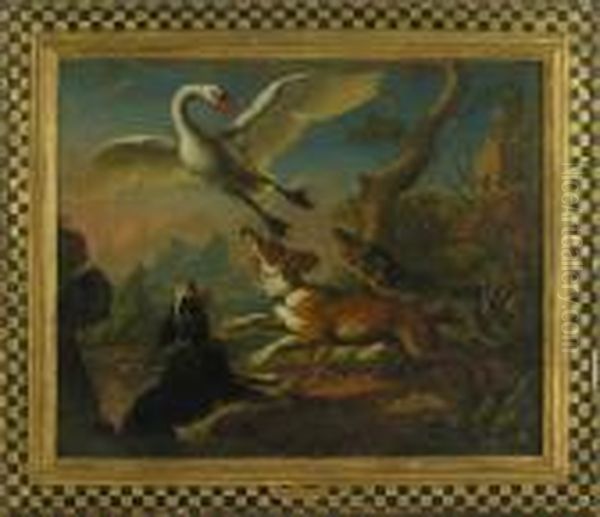
Around 1659, Hondius left his native Rotterdam and relocated to Amsterdam, the vibrant commercial and cultural heart of the Dutch Republic. This move placed him in a larger, more competitive art market, potentially offering greater opportunities for patronage and exposure. While specific details of his activities in Amsterdam are less documented than his time in Rotterdam or London, he continued to paint, likely further refining his style and expanding his network. The Amsterdam art scene was rich with talent, including masters like Rembrandt van Rijn (though Rembrandt's later years coincided with Hondius's time there) and numerous specialists in landscape, marine painting, still life, and genre scenes.
A more significant shift occurred in 1666 when Hondius moved to London. This move coincided with a period when foreign artists, particularly from the Low Countries, found patronage in England. The reasons for his relocation are not explicitly recorded but could involve seeking new markets, escaping competition in Amsterdam, or specific commissions. He would spend the remainder of his life, roughly a quarter-century, in London, dying there in 1691.
His time in London proved productive. He continued to focus on his signature animal and hunting scenes, which found favour among English patrons who shared the European aristocracy's taste for such subjects. Works depicting stag hunts, boar hunts, and dogs attacking various prey remained central to his output. However, his London period also saw him engage with the local environment. He produced notable paintings of London itself, including views of the River Thames, such as the famous A Frost Fair on the Thames at Temple Stairs (c. 1684, Museum of London), depicting the ice fairs held during severe winters, and views incorporating London Bridge. These works demonstrate his skills as a landscape and cityscape painter, capturing the atmosphere and specific details of his adopted city. Despite this diversification, animal painting remained his primary focus and the foundation of his reputation throughout his London years.
Thematic Focus: The Animal Kingdom and the Thrill of the Hunt
The core of Abraham Hondius's artistic identity lies in his fascination with the animal world, particularly its more dramatic and untamed aspects. Well over half of his known works – paintings, etchings, and drawings – feature animals as the central subject. His repertoire included hunting scenes, depictions of animals fighting, and more tranquil studies of animals at rest. Dogs, especially hunting hounds, were a recurring and expertly rendered motif. He captured their musculature, energy, and various breeds with convincing realism.
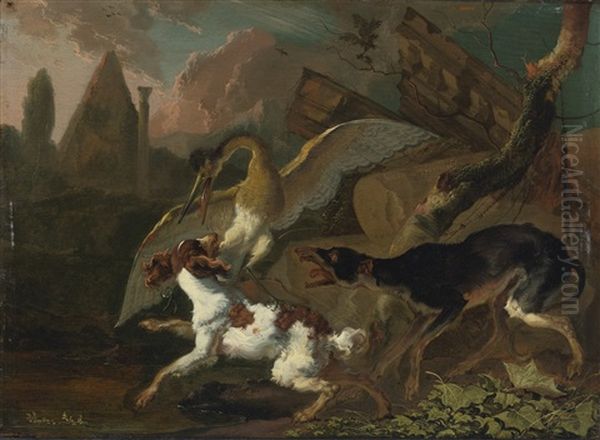
His hunting scenes often depict the climax of the chase: hounds closing in on a stag, boar, or bear, or flushing out birds. Works like Hounds Putting Up a Swan or the etching Honden Jagen Op Een Beer (Hounds Hunting a Bear) exemplify his ability to convey intense action and the primal struggle between predator and prey. These scenes are not merely descriptive; they are imbued with Baroque dynamism, capturing the ferocity and movement inherent in the hunt. The compositions are often complex, with multiple figures and animals interacting within a landscape setting.
Beyond the hunt, Hondius explored other animal interactions. Paintings like A Bird and Dog Fighting showcase his interest in depicting animal aggression and natural behaviour. He also produced studies of individual animals or groups, such as Hounds Resting, demonstrating his skill in portraying animals in quieter moments, focusing on their form and texture. His approach combined the detailed observation characteristic of Dutch realism with the dramatic flair influenced by Flemish masters like Snyders. He paid close attention to the textures of fur and feathers, the tension in muscles, and the expressions – however anthropomorphized – of the animals involved. This focus on animal life, rendered with technical skill and dramatic sensibility, distinguishes Hondius within the broader landscape of Dutch Golden Age art.
Expanding Horizons: Landscapes, Religious Scenes, and Genre
While renowned for his animal paintings, Hondius demonstrated competence and creativity in other genres as well, showcasing a versatility common among many artists of the era. His move to London notably spurred his production of cityscapes and landscapes. The aforementioned A Frost Fair on the Thames is a prime example, offering a lively panoramic view of a specific historical event and capturing the wintry atmosphere and bustling human activity on the frozen river. Other views of London Bridge and the Thames further attest to his ability to handle architectural elements and atmospheric perspective.
Hondius also ventured into religious and mythological subjects, though these form a smaller part of his oeuvre compared to his animal scenes. An early work, Landscape with Saint Hubert and the Stag (c. 1650), combines his interest in landscape and animals with a religious narrative. The story of Saint Hubert, the patron saint of hunters who converted after encountering a stag with a crucifix between its antlers, was a natural fit for an artist specializing in hunt-related themes. Another example is The Adoration of the Shepherds, where he applied his skills in composition and light handling to a traditional biblical scene, often imbuing it with a rustic realism reminiscent of his genre influences.

His engagement with genre painting, depicting scenes of everyday life, is less prominent but present. Elements of genre can be seen in the human figures populating his landscapes or accompanying his hunting parties. The influence of his teacher Pieter de Bloot, a specialist in peasant scenes, might be detected here. Although he never fully specialized in these areas to the extent he did with animal painting, his work across these genres demonstrates a broad artistic capability and a willingness to engage with the diverse thematic demands of the art market in Rotterdam, Amsterdam, and London. This versatility adds depth to our understanding of Hondius as an artist navigating the rich currents of 17th-century European painting.
Artistic Style and Technical Prowess
Abraham Hondius's style is characterized by a synthesis of influences, technical proficiency, and a distinct thematic focus. His grounding in the Dutch tradition is evident in his attention to detail, the realistic rendering of textures (fur, feathers, foliage), and his handling of light and shadow to create volume and atmosphere. This meticulousness aligns with the broader tendencies of Dutch Golden Age painting, seen in the works of contemporaries like Gerrit Dou or Frans van Mieris the Elder in fijnschilder painting, although Hondius worked on a generally larger scale and with more dynamic subjects.
However, his style is equally indebted to the Flemish Baroque, particularly in his animal and hunting scenes. The energy, movement, and often violent drama of these works echo the compositions of Frans Snyders and Paul de Vos. Hondius employed diagonal lines, crowded compositions, and dramatic poses to convey the intensity of the hunt or animal combat. His colour palette could range from the more subdued, earthy tones typical of some Dutch landscapes to brighter, more varied colours, especially in his depictions of fabrics or exotic elements.
Hondius worked proficiently across different media. While primarily known for his oil paintings, he was also an accomplished etcher and draughtsman. His etchings, such as Wild Boar and Hounds Hunting a Bear, demonstrate a confident handling of line and tone to achieve dramatic effects comparable to his paintings. His drawings often served as studies for larger works, revealing his process of observing animal anatomy and movement. Despite his technical skills and the absorption of various influences, art historians note that Hondius seemed to constantly strive for a unique, personal style, sometimes struggling to fully integrate or move beyond the models provided by his predecessors and contemporaries. This ongoing negotiation between influence and individuality is itself a fascinating aspect of his artistic journey.
Contemporaries, Connections, and the Wider Art World
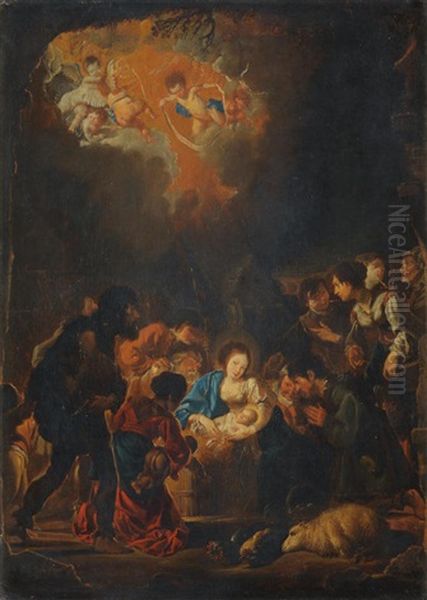
Hondius operated within a vibrant and interconnected European art world. His training placed him alongside Rotterdam contemporaries like Ludolf de Jongh and his teacher Cornelis Saftleven. His move to Amsterdam brought him into proximity with the later works of Rembrandt and the diverse specialists of that city, such as the landscape painters Jacob van Ruisdael and Meindert Hobbema, or the genre painter Jan Steen, although direct interactions are not documented.
His specialization in animal painting placed him in dialogue with other Dutch artists known for similar subjects. Paulus Potter (1625–1654), famous for his depictions of cattle and farm animals, represented a more pastoral counterpoint to Hondius's often dramatic scenes. Aelbert Cuyp (1620–1691), from Dordrecht, incorporated animals masterfully into his luminous landscapes. Philips Wouwerman (1619–1668), based in Haarlem, excelled in depicting horses, battles, and hunting parties, sharing some thematic ground with Hondius but with a distinct, often more elegant style. Melchior d'Hondecoeter (1636–1695), working primarily in Amsterdam, became the preeminent Dutch painter of birds, both domestic and exotic, often in park-like settings.
In London, Hondius joined a community that included native English painters as well as other immigrant artists, particularly from the Netherlands, such as the marine painters Willem van de Velde the Elder and Younger. His work would have been seen alongside that of Peter Lely, the dominant portrait painter in England after Van Dyck. While Hondius focused on his established specializations, his presence contributed to the diversity of the London art scene. His works, particularly the hunting scenes, catered to the tastes of the English aristocracy and gentry, who valued depictions of field sports. Although no direct students of Hondius are recorded, his distinctive style and popular subject matter likely influenced other painters of animals and sporting scenes in England during the later 17th century. His connection to Flemish masters like Snyders also linked him to a broader European tradition highly valued by collectors.
Legacy, Collections, and Reputation
Abraham Danielsz Hondius enjoyed a degree of success during his lifetime, evidenced by his ability to sustain a career across three major cities and the survival of a considerable body of work. His reputation rests firmly on his skill as an animal painter, particularly his dynamic and often dramatic hunting scenes. He successfully bridged the detailed realism associated with Dutch painting and the energetic dynamism of the Flemish Baroque tradition exemplified by Snyders and Fyt.
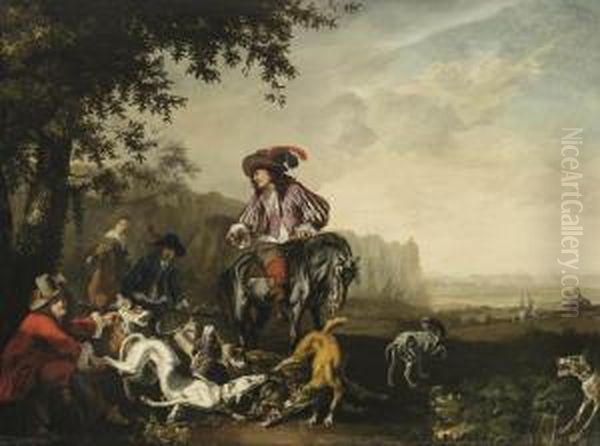
While perhaps not achieving the very highest tier of fame occupied by figures like Rembrandt or Vermeer, Hondius was a respected specialist whose work was collected and appreciated. His paintings and etchings entered collections across Europe. Today, his works are held by numerous prestigious museums and galleries worldwide. Key institutions include:
The Rijksmuseum in Amsterdam.
The Museum Boijmans Van Beuningen in Rotterdam.
The Metropolitan Museum of Art in New York.
The Victoria and Albert Museum (V&A) in London, which holds etchings like Hounds Hunting a Bear.
The Museum of London, home to his famous Frost Fair on the Thames.
The Institut Collectie Nederland (now the Rijksdienst voor het Cultureel Erfgoed), holding works like the early Landscape with Saint Hubert and the Stag.
The Raczyński Library in Poznan, Poland, possessing his etching Wild Boar.
The Tate Britain in London also holds examples of his work.
His legacy lies in his contribution to the genre of animal painting within the Dutch Golden Age and his role in transmitting and adapting Flemish influences within both Dutch and English contexts. His detailed yet vigorous style provided a distinctive take on subjects popular with patrons, ensuring his works remain engaging examples of 17th-century European art. Though he may have wrestled with finding a completely independent artistic voice, his synthesis of traditions and his undeniable skill in capturing the animal world secure his place as a noteworthy master of his time.
Conclusion
Abraham Danielsz Hondius navigated the complex artistic landscape of the 17th century with considerable skill and adaptability. From his training in Rotterdam under De Bloot and Saftleven, through his engagement with the Amsterdam art market, to his final productive decades in London, he remained largely dedicated to the depiction of animals, particularly in the context of the hunt. His work vividly reflects the cross-currents between Dutch realism and Flemish Baroque energy, absorbing influences from masters like Snyders, Fyt, and Saftleven while developing a recognizable, if not entirely unique, style. His ability to render the ferocity of animal combat, the tension of the chase, and the textures of the natural world, combined with his excursions into landscape and cityscape, mark him as a versatile and accomplished painter. Hondius's surviving works in major collections continue to testify to his talent and offer a compelling window into the artistic tastes and cultural preoccupations of the Dutch Golden Age and Restoration England.